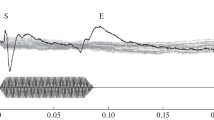Studies of neuron activity in animals have shown that the brainstem is involved in processing the ends of sounds. We report here an analysis of the reaction of the human midbrain to the ends of sound stimuli. Electrical activity was recorded using a depth electrode located in the cerebral aqueduct. The study was conducted as part of intraoperative monitoring (IOM) with the aim of minimizing neurological deficit in the postoperative period. Results of the analysis of evoked potentials recorded in response to simple tones in six patients are presented. Evoked potentials arising after the start of the sound stimulus showed VS, VIS, S1S, S2S, S3S peaks, associated with nerve impulse conduction along the auditory pathway. The end of the sound stimulus was followed by VE, VIE, S1E, S2E, S3E peaks, which are also associated with the nerve impulse conduction along the auditory pathway, along with the E peak, which most likely reflects the analysis of sound information by midbrain structures.
Similar content being viewed by others
References
Akimov, A. G., Egorova, M. A., and Ehret, G., “Spectral summation and facilitation in on- and off-responses for optimized representation of communication calls in mouse inferior colliculus,” Eur. J. Neurosci., 45, 440–459 (2017).
Alluri, R. K., Rose, G. J., Hanson, J. L., et al., “Phasic, suprathreshold excitation and sustained inhibition underlie neuronal selectivity for short-duration sounds,” Proc. Natl. Acad. Sci. USA, 113, E1927–E1935 (2016).
Anderson, L. A. and Linden, J. F., “Mind the gap: Two dissociable mechanisms of temporal processing in the auditory system,” J. Neurosci., 36, No. 6, 1977–1995 (2016).
Baba, H., Tsukano, H., Hishida, R., et al., “Auditory cortical field coding long-lasting tonal offsets in mice,” Sci. Rep., 6, 1–11 (2016).
Behr, R., Colletti, V., Matthies, C., et al., “New outcomes with auditory brainstem implants in NF2 patients,” Otol. Neurotol., 35, 1844–1851 (2014).
Brinkmann, R. D. and Scherg, M., “Human auditory on- and off-potentials of the brainstem: Influence of Stimulus Envelope Characteristics,” Scand. Audiol., 8, 27–32 (1979).
Casseday, J., Ehrlich, D., and Covey, E., “Neural tuning for sound duration: role of inhibitory mechanisms in the inferior colliculus,” Science, 264, No. 5160, 847–850 (1994).
Dhanasingh, A. and Hochmair, I., “ABI-auditory brainstem implant,” Acta Otolaryngol., 141, Suppl. 1, 63–81 (2021).
Duque, D., Wang, X., Nieto-Diego, J., et al., “Neurons in the inferior colliculus of the rat show stimulus-specific adaptation for frequency, but not for intensity,” Sci. Rep., 6, 24114 (2016).
Kantserova, A. O., Oknina, L. B., Pitskhelauri, D. I., et al., “Midbrain evoked potentials associated with the beginning and end of a simple tone,” Fiziol. Cheloveka, 48, No. 3, 5–13 (2022).
Kopp-Scheinpflug, C., Sinclair, J. L., and Linden, J. F., “When sound stops: Offset responses in the auditory system,” Trends Neurosci., 41, 712–728 (2018).
Liu, J., Whiteway, M. R., Sheikhattar, A., et al., “Parallel processing of sound dynamics across mouse auditory cortex via spatially patterned thalamic inputs and distinct areal intracortical circuits,” Cell Rep., 27, 872–885.e7 (2019).
Michels, T. C., Duffy, M. T., and Rogers, D. J., “Hearing loss in adults: Differential diagnosis and treatment,” Am. Fam. Physician, 100, 98–108 (2019).
Naples, J. G. and Ruckenstein, M. J., “Cochlear Implant,” Otolaryngol. Clin. North Am., 53, 87–102 (2020).
Parsons, C. E., Young, K. S., Joensson, M., et al., “Ready for action: A role for the human midbrain in responding to infant vocalizations,” Soc. Cogn. Affect. Neurosci., 9, 977–984 (2014).
Potter, H., “Patterns of acoustically evoked discharges of neurons in the mesencephalon of the bullfrog,” J. Neurophysiol., 28, No. 6, 1155–1184 (1965).
Sahinovic, M. M., Struys, M. M. R. F., and Absalom, A. R., “Clinical pharmacokinetics and Pharmacodynamics of Propofol,” Clin. Pharmacokinet., 57, 1539–1558 (2018).
Sala, F., Lanteri, P., and Bricolo, A., “Motor evoked potential monitoring for spinal cord and brain stem surgery,” Adv. Tech. Stand. Neurosurg., 29, 133–169 (2004).
Shaw, N. A., “The temporal relationship between the brainstem and primary cortical auditory evoked potentials,” Prog. Neurobiol., 47, 95–103 (1995).
Sołyga, M. and Barkat, T. R., “Distinct processing of tone offset in two primary auditory cortices,” Sci. Rep., 9, 1–12 (2019).
Swann, N. C., De Hemptinne, C., Miocinovic, S., et al., “Chronic multisite brain recordings from a totally implantable bidirectional neural interface: experience in 5 patients with Parkinson’s disease,” J. Neurosurg., 128, 605–616 (2018).
Valentinuzzi, M. E., “Hearing aid history: From ear trumpets to digital technology,” IEEE Pulse, 11, 33–36 (2020).
World Health Organization (WHO), World Report on Hearing: Executive Summary [Russian version].
Author information
Authors and Affiliations
Corresponding author
Additional information
Translated from Zhurnal Vysshei Nervnoi Deyatel’nosti imeni I. P. Pavlova, Vol. 72, No. 5, pp. 707–716, September–October, 2022.
Rights and permissions
Springer Nature or its licensor (e.g. a society or other partner) holds exclusive rights to this article under a publishing agreement with the author(s) or other rightsholder(s); author self-archiving of the accepted manuscript version of this article is solely governed by the terms of such publishing agreement and applicable law.
About this article
Cite this article
Kantserova, A.O., Oknina, L.B., Pitskhelauri, D.I. et al. Evoked Potentials Appearing in the Human Midbrain after Sounding of a Simple Tone. Neurosci Behav Physi 53, 358–364 (2023). https://doi.org/10.1007/s11055-023-01434-4
Received:
Accepted:
Published:
Issue Date:
DOI: https://doi.org/10.1007/s11055-023-01434-4




